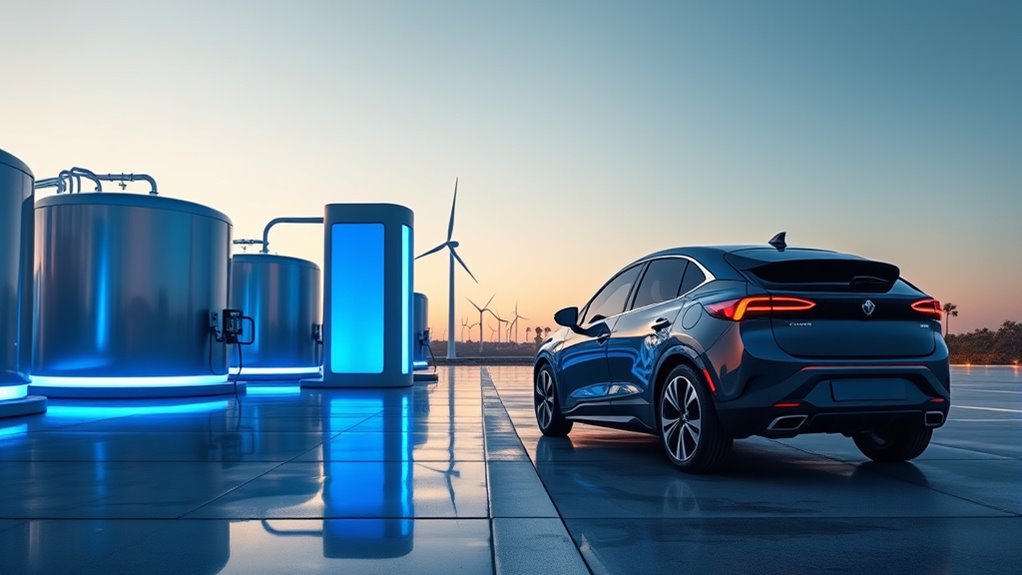By 2025, significant investments in renewable infrastructure like wind and solar, along with advanced energy storage solutions, are making hydrogen a practical and central part of the global energy system. These developments help address challenges of cost and scalability, enabling hydrogen to become a reliable clean energy source for various sectors. If you explore further, you’ll discover how these changes are accelerating hydrogen’s role in shaping a sustainable energy future.
Key Takeaways
- Significant investments in renewable infrastructure are expanding green hydrogen production capacity by 2025.
- Advances in energy storage solutions enable hydrogen to balance renewable energy intermittency effectively.
- Major projects and policies in 2025 aim to integrate hydrogen into transportation, industry, and power sectors.
- Progress in renewable energy tech is making hydrogen more cost-competitive and scalable globally.
- Infrastructure development and technological innovations are positioning hydrogen as a central clean energy solution.

Is hydrogen really the energy revolution it’s made out to be? That’s a question many are asking as 2025 approaches and new projects promise to reshape the way we think about clean energy. The buzz around hydrogen isn’t just hype; it’s rooted in its potential to transform sectors that are hard to decarbonize. But for hydrogen to truly become a cornerstone of our energy system, you need to understand the critical role of renewable infrastructure and energy storage. Without these, hydrogen’s promise remains theoretical rather than practical.
Renewable infrastructure is the backbone of a sustainable hydrogen economy. It involves building the wind turbines, solar farms, and electrolysis facilities necessary to produce “green hydrogen” — hydrogen generated using renewable energy sources. This infrastructure is key because it ensures that hydrogen production doesn’t rely on fossil fuels, making it genuinely clean. As investments pour into renewable projects, the capacity to produce hydrogen sustainably increases, making it more economically feasible and scalable. You’ll see countries and companies investing heavily in expanding this infrastructure, recognizing that without it, hydrogen can’t fulfill its promise of reducing carbon emissions.
Renewable infrastructure is vital for a sustainable, clean hydrogen economy and reducing carbon emissions.
Energy storage is another essential piece of the puzzle. Hydrogen acts as an excellent energy carrier, capable of storing excess renewable energy generated during peak times. When the sun isn’t shining or the wind isn’t blowing, stored hydrogen can be converted back into electricity or used directly as fuel. This flexibility is crucial because renewable energy sources are inherently intermittent. By integrating hydrogen into energy storage systems, you can smooth out supply fluctuations and ensure a reliable power grid. This not only stabilizes energy supplies but also makes renewable energy more practical for everyday use, from powering homes to fueling vehicles.
The development of a robust renewable infrastructure combined with advanced energy storage solutions positions hydrogen as a versatile and scalable clean energy source. You’ll see it integrated into various sectors — from transportation to industry — because it can store large amounts of energy and be transported efficiently. The investments made by governments and private companies in 2025 are setting the stage for a future where hydrogen isn’t just a niche technology but a central pillar of the global energy mix. While challenges remain, particularly in cost and infrastructure deployment, the momentum is undeniable. If you’re watching the transition unfold, it’s clear that hydrogen isn’t just hype — it’s a critical part of the sustainable energy future we’re building. Additionally, advancements in renewable energy technology are accelerating the pace of this transformation, making hydrogen even more viable.
Frequently Asked Questions
What Are the Main Challenges Hindering Hydrogen Infrastructure Development?
You face key challenges in developing hydrogen infrastructure, mainly due to market readiness and technological hurdles. The market isn’t fully prepared for widespread adoption, making investments risky. Additionally, technological hurdles like efficient storage, transportation, and production methods still need resolution. Overcoming these obstacles requires coordinated efforts, innovation, and policy support to build a reliable, scalable hydrogen infrastructure that can meet future energy demands effectively.
How Affordable Will Hydrogen-Powered Vehicles Become by 2025?
Hydrogen-powered vehicles will become astonishingly affordable by 2025, transforming your driving experience. As hydrogen costs decrease due to technological advances and increased production, vehicle affordability will soar, making these eco-friendly cars accessible to many. You’ll find that owning a hydrogen vehicle is no longer a distant dream but a practical, cost-effective choice—changing the way you think about transportation and sustainability forever.
What Safety Concerns Are Associated With Hydrogen Storage and Transport?
You should know that storing and transporting hydrogen raises safety concerns like potential hydrogen leakages, which can lead to dangerous accumulations. There’s also the risk of storage explosion, especially if leakages occur near sparks or heat sources. Proper safety measures, such as robust containment systems and leak detection technology, are essential to minimize these risks, ensuring safe handling during storage and transport of hydrogen.
How Will Government Policies Influence Hydrogen Market Growth?
Did you know that government policies can boost hydrogen market growth by up to 50%? You’ll see policy incentives and clear regulatory frameworks play a pivotal role in this. They encourage investments, reduce risks, and accelerate adoption. As you follow these developments, you’ll notice stronger public support and industry confidence. Governments shaping these policies will directly influence how quickly hydrogen becomes a mainstream energy source, making the future more sustainable and innovative.
What Are the Environmental Impacts of Large-Scale Hydrogen Production?
You should consider the environmental impacts of large-scale hydrogen production. It can increase the environmental footprint if produced via fossil fuels, contributing to greenhouse gases. Additionally, resource depletion might occur, especially if water is heavily used in processes like electrolysis. To reduce these effects, sustainable methods like green hydrogen, which use renewable energy, are essential. This way, you minimize environmental harm and promote a cleaner, more sustainable energy future.
Conclusion
As you stand on the brink of 2025, the hydrogen economy is like a rising tide, promising to lift industries and reshape our future. The momentum is undeniable, and your role in this shift is essential. Embrace the opportunities ahead, because this wave of innovation isn’t just a passing current—it’s the dawn of a new era. Get ready to ride the wave, because hydrogen’s journey is just beginning, and you’re part of its unstoppable surge.









